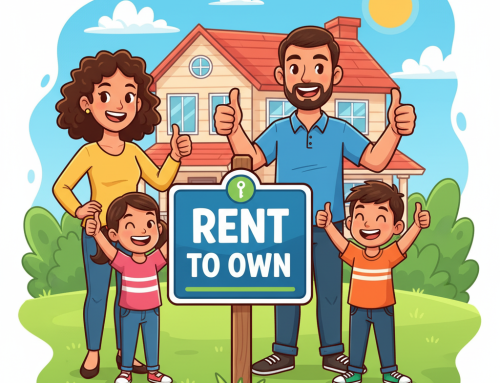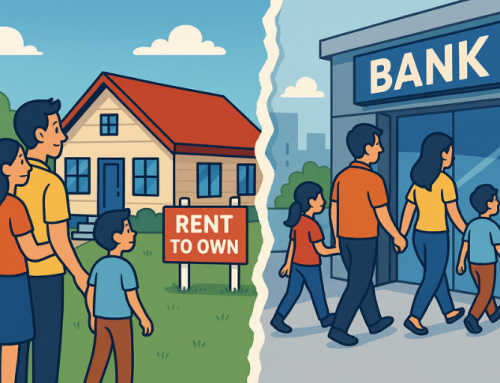Rent-to-Own vs. Private Mortgage: Which Path to Homeownership Makes Sense for You?
For many aspiring homeowners in Ontario and Alberta, the traditional mortgage route isn’t always an option. Whether it’s because of a short credit history, self-employment income, or not having enough saved for closing costs, getting bank approval can feel impossible.
When this happens, two common alternatives come up: rent-to-own and private mortgages. Both offer a way to get into a home, but they work very differently. Understanding the pros and cons of each can help you make the smartest choice for your situation.
What is a Private Mortgage?
A private mortgage is a loan provided by an individual, group of investors, or private lending company instead of a bank or credit union. These mortgages are often used as short-term solutions—usually 1 to 3 years—when buyers don’t qualify with traditional lenders.
Pros of a Private Mortgage
-
✅ Fast approval: Private lenders focus more on the property’s value than your credit score.
-
✅ Flexible requirements: Self-employed, new to Canada, or credit-challenged buyers may still qualify.
-
✅ Short-term bridge: Can be useful if you need quick financing until you qualify with a bank.
Cons of a Private Mortgage
-
❌ High interest rates: Could be double (or more) the rates offered by banks.
-
❌ Additional fees: Expect to pay lender fees (1–3%), broker fees, and legal fees upfront.
-
❌ Short terms: Usually only 12 months, which means you’ll need to refinance quickly.
-
❌ Risk of foreclosure: If you can’t refinance in time, you may lose the home.
What is Rent-to-Own?
Rent-to-own is a program that allows you to move into your future home today while working toward mortgage approval over time. You rent the property for a set period (typically 3–4 years) with a portion of your monthly payment building your future down payment. The purchase price is locked in from day one.
Pros of Rent-to-Own
-
✅ Locked-in purchase price: Protects you from rising home prices.
-
✅ Builds your down payment: Monthly credits accumulate toward your purchase.
-
✅ No closing costs upfront: Unlike private mortgages, you don’t need thousands extra for fees.
-
✅ Credit repair support: Many programs provide guidance to help you get mortgage-ready.
-
✅ Security of ownership plan: You live in the home you’ll eventually own.
Cons of Rent-to-Own
-
❌ Commitment required: You must follow the plan to improve credit and manage debt.
-
❌ Not immediate ownership: The title stays with the investor until you qualify for a mortgage.
-
❌ Monthly payments can be higher than rent: Because the payments are based on mortgage expenses
Rent-to-Own vs. Private Mortgage: Key Differences
| Feature | Rent-to-Own | Private Mortgage |
|---|---|---|
| Upfront Costs | Down payment (often 5%) | Down payment + lender fees + broker fees + legal fees |
| Credit Requirements | Flexible; plan supports credit repair | Flexible, but higher risk = higher cost |
| Ownership | Future purchase after program | Immediate ownership |
| Purchase Price | Locked in from start | Based on market value at time of purchase |
| Monthly Payments | Includes rent + savings credits | High mortgage payments + interest |
| Risk | Must complete program to succeed | Risk of losing home if refinancing fails |
Which Option is Better?
Choosing between rent-to-own and a private mortgage depends on your situation:
-
If you need ownership today and can handle high costs short-term, a private mortgage may work—though it’s risky.
-
If you want stability, a locked-in price, and a clear plan to qualify for a mortgage, rent-to-own is often the smarter, safer path.
With rent-to-own, you don’t just get into a home—you build equity, protect yourself from market increases, and have time to strengthen your finances for long-term ownership success.
Final Thoughts
Private mortgages and rent-to-own both exist to help buyers who can’t qualify with a bank today. But while private mortgages often act as a band-aid solution with high costs and short terms, rent-to-own provides a long-term strategy with built-in support.
If you’re serious about becoming a homeowner and want a plan that works for real families—not just banks and lenders—rent-to-own may be your best next step.
Check this out to see the 7-myths that could be stopping you from getting into homeownership today
Pre-qualify today to find out if you’re a fit for our proven Rent-to-Own program.







Leave A Comment